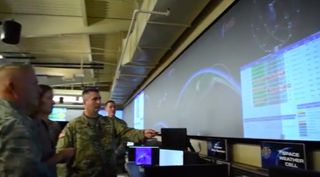Air Force Launches $100K Challenge for 'Space Awareness Innovators'

WASHINGTON — The U.S. Air Force and the Wright Brothers Institute are offering cash prizes for creative visualization tools — such as augmented reality and virtual reality — that can enhance military space operators' understanding and awareness of satellites and other objects in space.
The Air Force Visionary Q-Prize Competition, or VQ-Prize, is set to run from Oct. 29 through Jan. 15, 2019.
Up to $100,000 in prize money will be distributed in this competition, according to an Air Force news release.
There will be multiple awards for different categories and a single VQ-Prize will go to the top overall submission. Specific competition guidelines, prizes, dates, grading criteria, data sets, and submission details will be posted at https://www.innocentive.com/ar/challenge/9934120
The VQ-Prize was conceived to encourage nontraditional vendors to engage with the military. The Air Force is aiming this challenge at universities, individuals and small businesses that can help "find solutions for safe and secure operations in space." No background in space is required.
"The need for timely and accurate object tracking is paramount to the defense of space," said Brig. Gen. William Liquori, Air Force Space Command Strategic Requirements, Architectures and Analysis director. He said the competition is to help "augment existing capabilities with visualization tools that enable operators to intuitively absorb and quickly navigate massive amounts of space object data."
The Air Force wants tools that use existing data, displaying and processing it in a manner that thoroughly captures the space picture, while also facilitating "quick comprehension of changes," the news release said.
Col. Michael Kleppe, Air Force Space Command Space Capabilities Division director said it is "imperative that space operators receive up-to-date information on this rapidly evolving and highly dynamic environment." They must also be able to "quickly process and interpret the information necessary for decisive action on compressed timelines."
Get the Space.com Newsletter
Breaking space news, the latest updates on rocket launches, skywatching events and more!
For the competition, specific problems have been scoped and packaged. Contestants may submit traditional user interface solutions, displayed or projected on a flat screen, or AR/VR interfaces.
Contestants will need to present new ways of visualizing and understanding the following types of events: Satellite maneuvers, high-speed conjunctions in low Earth orbit, proximity operations and relative orbital activity in geosynchronous Earth orbit, new object discovery, satellite and debris breakups, constellation insertions of multiple satellites on a single launch, and lost or "stale" objects.
Submissions will be evaluated by military space operators, space development professionals, and human factors experts. Some considerations include: Clear presentation of information, ability to search for and display specific objects or constellations, support of user recognition rather than recall, ability to monitor all critical information simultaneously, lack of clutter and extraneous information, and lack of over-stimulation of the user.
This story was provided by SpaceNews, dedicated to covering all aspects of the space industry.
Join our Space Forums to keep talking space on the latest missions, night sky and more! And if you have a news tip, correction or comment, let us know at: community@space.com.

Sandra Erwin covers the military and national security beat as a Senior Staff Writer at SpaceNews. Sandra, based in Arlington, Virginia, specializes in Defense Department and Intelligence Community space programs, policy, budgets, technology and the industry that supports this sector. She joined SpaceNews in October 2017. Before coming to SpaceNews, Erwin covered the U.S. military, the Pentagon, Congress and the defense industry for over two decades as editor of the National Defense Industrial Association's National Defense Magazine and Pentagon correspondent for Real Clear Defense.

